The NSW Government releases its consultation paper for the Central-West Orana REZ
08 February 2022

08 February 2022

What you need to know
The current open access arrangements in the NEM give generators the right to negotiate connection to transmission or distribution networks. However, this has created the following challenges:
Successful proponents who are awarded an access right will receive the following entitlements for the access scheme term (i.e. 15 years from the commissioning of the first substation on the REZ Scheme Network):
The overarching objective of the access rights regime is to maximise the efficient usage of the transmission asset (i.e. the REZ Scheme Network), whilst providing sufficient certainty to proponents regarding their curtailment risk.
The access scheme declaration will apply to the REZ Network Infrastructure and is designed to support the access rights regime. The access scheme is based on a physical connection model with access rights initially being awarded up to an initial aggregate maximum capacity cap. By providing for a limit on the capacity that connects to the REZ network infrastructure up to the targeted level of transmission curtailment, proponents will be given certainty that additional projects will not be connected in the second allocation of access rights if the target transmission curtailment level is forecast to be met or exceeded. This certainty allows proponents to be able to better forecast NEM locational price signals, such as marginal loss factor and curtailment.
The target transmission curtailment level is intended to provide flexibility to grant access rights above the initial allocation of access rights where the network is considered under-utilised, including when the intended network capacity of a REZ is increased by EnergyCo NSW. This flexibility ensures that the efficient usage of the REZ Scheme Network is maximised.
The graphs below depict the design elements which are key to understanding the access scheme and the proposed allocation approach of access rights. We provide a brief description of each of the key elements below.
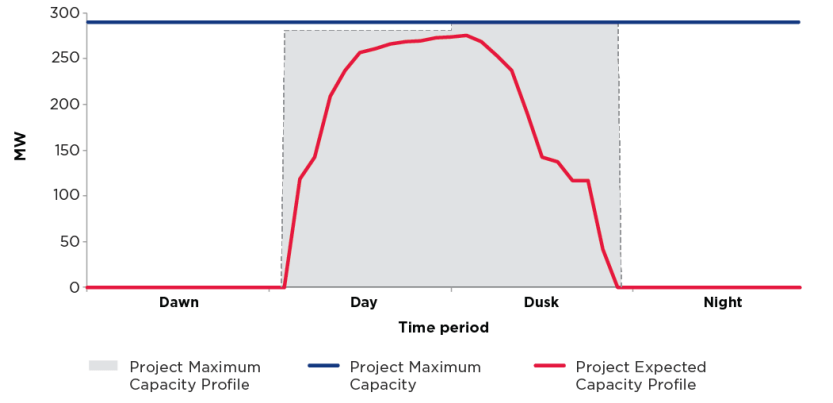
| DESIGN ELEMENT | DESCRIPTION |
|---|---|
| Project Maximum Capacity | A project's Maximum Capacity refers to the flat, sent-out generation limit on a generation project. |
| Project Maximum Capacity Profile | A project's Maximum Capacity Profile describes the Maximum Capacity for four periods of the day - dawn, day, dusk and night. For example, the Maximum Capacity Profile of a solar project would be set at zero for the 'night' period, but would be much higher during the 'day' period. |
| Project Expected Capacity Profile | While the Maximum Capacity Profile illustrates the generation limit, the Expected Capacity Profile represents the forecast generation for each dispatch interval in a forecast year. For example, wind or solar projects would utilise weather data for the REZ to provide the Expected Capacity Profile. Notably, it is intended that the scheme may permit projects to expand over phases and increase its Maximum Capacity Profile or Expected Capacity Profile over time, subject to the expansion not adversely impacting other projects. Additionally, whilst initially the Department does not foresee it happening in the CWO REZ, there may be an opportunity for a generator to share capacity with a third party battery within a REZ in the future. It is envisaged that commercial and legal mechanisms may allow tradability and in the future this option may be made available. |
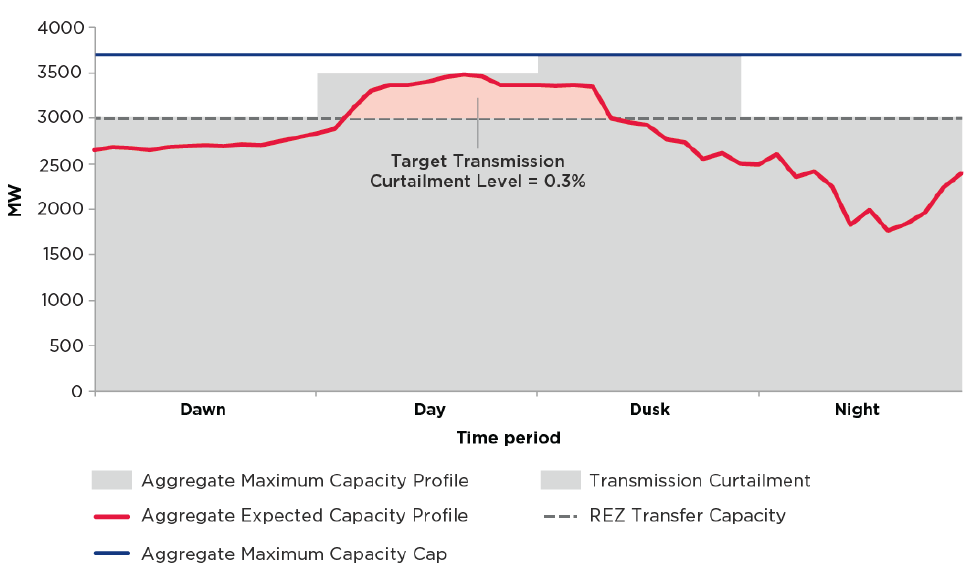
| DESIGN ELEMENT | DESCRIPTION |
|---|---|
| Aggregate Maximum Capacity Profile | The Aggregate Maximum Capacity Profile simply aggregates the Maximum Capacity Profiles of all the projects within the CWO REZ. Proponents are expected to nominate a Maximum Capacity Profile at the project level during the competitive tender process. The aggregation of this data will then be used to calculate the Aggregate Maximum Capacity Profile. |
| REZ Transfer Capacity | The REZ Transfer Capacity refers to the transfer capacity of the CWO REZ transmission network, which is assumed to be 3 GW. |
| Aggregate Maximum Capacity Cap | The Aggregate Maximum Capacity Cap is a limit on the highest capacity that the Aggregate Maximum Capacity Profile will be allowed to reach upon allocation of the projects. The first allocation's cap will be set in the access scheme declaration, for a volume of access rights which is intended to be an efficient over-subscription of the REZ Transfer Capacity. For the CWO REZ, the proposed Aggregate Maximum Capacity Cap is 3.69 GW. |
| Aggregate Expected Capacity Profile | The Aggregate Expected Capacity Profile aggregates all of the Expected Capacity Profiles of all the projects in the CWO REZ. |
| Target Transmission Curtailment Level | The Target Transmission Curtailment Level refers to the extent to which the Aggregate Expected Capacity Profile is forecast to exceed the REZ Transfer Capacity. Indicative modelling for the CWO REZ suggests that this curtailment level would be set at 0.3% of the annual volume of forecast generation availability for the projects in the first allocation of access rights. The Target Transmission Curtailment Level reflects only one aspect of curtailment (i.e. curtailment driven by technical constraints inside the REZ) and excludes curtailment driven by technical constraints outside the REZ and curtailment driven by economic spill. The target transmission curtailment level will be defined in the access scheme declaration and cannot be amended for the term of the access scheme. The Target Transmission Curtailment Level following the first allocation of projects will be used to assess whether the second allocation should proceed. |
What type of projects are eligible to apply for LTESAs and access rights?
Access rights will be tendered through a combined competitive process run by AEMO Services, whereby generators and storage providers will bid for an access right with an LTESA, if preferred, or they will just bid for an access right if they are not seeking an LTESA (or vice versa depending on the type of project).
At the end of the LTESA/access rights tender evaluation process, AEMO Services will recommend:
Proponents that require an access right and an LTESA for a project must obtain these in a single competitive tender round. To mitigate proponents gaining an unintended advantage in the competitive tender process, AEMO Services will prevent projects that bid for, and are successful in obtaining, an LTESA (but not an access right) from seeking an access right in a later tender round and vice versa. Some flexibility may be permissible in limited circumstances where proponents have acted in good faith and an exemption to apply separately for an access right and an LTESA is in the best interest of NSW electricity consumers.
While future competitive tenders for LTESAs and access rights will typically be combined into a single process, an exception has been made for the first tender due to the ongoing design and planning for the CWO REZ. The first tender will be run as a pilot in the second quarter of 2022 for eligible generation and long duration storage projects.
Irrespective of whether proponents seek an LTESA, an access right or a combination of both, they will be required to enter into Project Delivery Agreements which set and monitor tender bid undertakings, including project development milestones, reporting requirements, community and employment commitments and bonding arrangements.
In summary, successful proponents seeking:
The below table sets out what types of projects are eligible to apply for LTESAs and/or access rights and which allocation of access rights they will be entitled to.
| PROJECT TYPE | RIGHT TO CONNECT TO REZ SCHEME NETWORK | ALLOCATION 1 | ALLOCATIONS 2 AND 3 |
|---|---|---|---|
| Generation projects greater than 30 MW seeking to connect to REZ Scheme Network | Required to hold an access right | Eligible to apply for Allocation 1 (if eligible to apply for a generation LTESA) | Eligible to apply for Allocations 2 and 3 |
| Generation projects less than 30 MW seeking to connect to REZ Scheme Network | Required to hold an access right | Not eligible to apply for Allocation 1 (unless considered in aggregate with other projects to be greater than 30 MW and therefore eligible for a generation LTESA) | Eligible to apply for Allocations 2 and 3 |
| Generation projects greater than 30 MW seeking to connect outside REZ ("outstanding merit" projects) | Eligible to apply for a generation LTESA (but not an access right) | Permitted to connect under current NEL and NER arrangements | |
| Long-duration storage projects of any size seeking to connect to REZ Scheme Network | Required to hold an access right | Eligible to apply for Allocation 1 (if eligible for a long duration storage LTESA or a generation LTESA via a hybrid generation/storage project) | Eligible to apply for Allocations 2 and 3 |
| Short-duration storage projects of any size seeking to connect to REZ Scheme Network | Required to hold an access right | Not eligible to apply for Allocation 1 (unless eligible for a generation LTESA via a hybrid generation/storage project) | Eligible to apply for Allocations 2 and 3 |
| Any generation or storage project of any size seeking to connect to existing infrastructure that does not form part of the REZ Scheme Network (whether inside or outside the geographical bounds of the REZ) | Required to seek permission from EnergyCo NSW to connect in accordance with the access scheme control mechanism (unless exempt under 6 month grandfathering arrangements from the date of the access scheme declaration) (see further below) | Permitted to connect under current NEL and NER arrangements | |
| Any load seeking to connect to the REZ Scheme Network | Not required to hold an access right or pay an access fee | Permitted to connect under current NEL and NER arrangements | |
The allocation of access rights will be staged into three phases. By choosing to provide for three phases of allocations, the Department is seeking to optimise consumer outcomes whilst meeting the policy objectives of providing certainty to proponent generators, ensuring efficient utilisation of the REZ Scheme Network and supporting the ability for proponents to fund augmentation of the REZ Scheme Network. The three phases of allocations are as follows:
Applying the NEM fee model to the REZ would result in consumers paying for the shared REZ network and generation projects paying the cost of their connections to that REZ network. AEMO Services is currently contemplating whether to deviate from this model and whether access fees should recoup network related costs in part or full.
Generators who are successfully allocated LTESA/access rights will be required to pay access fees. The quantum will vary based on different categories of access, including access rights or subordinate access rights or any other access permitted to REZ Network Infrastructure beyond the intended network capacity of the REZ.
No conclusions have been made on the quantum of the access fee as yet, however, it is anticipated that there will be a minimum access fee, which will be comprised of community benefit fees and regional economic benefit fees (see below). The access fee will also factor in the administrative costs of administering the access scheme.
Above the regulatory minimum, AEMO Services may determine higher fees to be paid in order to discharge its statutory duty to act in the long-term financial interests of NSW electricity customers. In addition, AEMO Services will aim to ensure that the access fee will avoid creating unacceptable barriers for entry into, or utilisation of the, REZ infrastructure and not materially impact LTESA fixed prices, option exercise behaviour and contract market liquidity.
The access fee will likely be set on an equal per unit basis irrespective of generation type in order to maintain technology neutrality. The mechanism being proposed to recover access fees could be an up-front capital payment, ongoing annuity payments or a combination of both.
Aside from the construction and maintenance of the CWO REZ infrastructure itself, the access fees will be used for two alternative purposes. A portion of the access fees will be directed to benefit the REZ communities, named the "community purpose". Another portion of the access fees will be directed to promoting regional economic development, including supporting employment, skills and training of employees inside a REZ who are affected by changes in electricity generation in NSW.
Loads are encouraged to directly connect to the CWO REZ infrastructure to maximise the utilisation of the REZ Scheme Network and reduce curtailment risks. At this point, a load will not be required to hold an access right or pay an access fee and will be permitted to connect to the REZ open access arrangements under current NEL and NER arrangements during any of the three REZ allocations.
No specific incentives are proposed for connecting a load to the REZ. Loads will only be charged network use-of-system costs associated with the existing shared transmission network up to the boundary points of the REZ, and will not be charged network fees associated with recovering the cost of the REZ network infrastructure. This provides a financial incentive for loads to connect, without increasing costs for generators.
The current NEM connection process has been recognised as a source of uncertainty and risk by many generation and storage developers seeking to connect to the grid. This is because the connection process has the potential to be long, expensive, lack transparency and subject to resource constraints from AEMO and transmission network service providers. The issues with the current open access regime have arisen, in part, because the connection process was not established to accommodate the unprecedented volume of connection applications that are currently being received.
The Department has sought to address some of the issues associated with the current connection process by proposing a more streamlined connection process. The objectives of the streamlined connection process are to minimise re-work of complex power system modelling, improve certainty of timeframes for proponents, reduce time to market and greater certainty of technical requirements at an earlier stage.
The streamlined network connection process (as depicted in the diagram below) will be integrated with the combined access rights and LTESA tender process and shall include the following four key design elements:
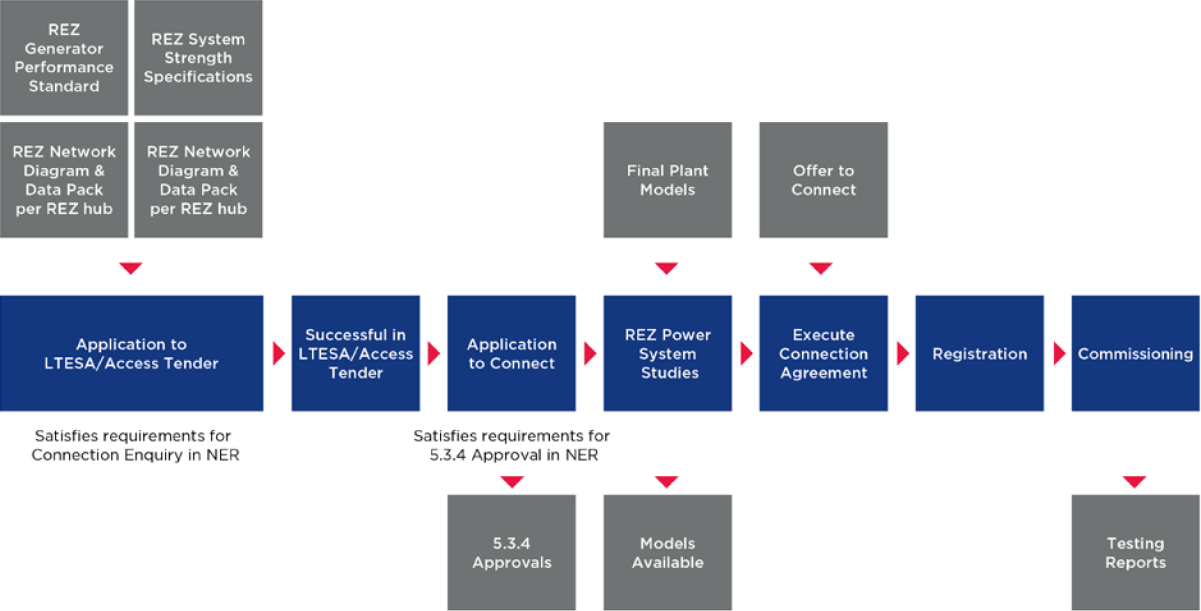
Under the CWO REZ, it is intended that EnergyCo NSW will facilitate AEMO and Transgrid in developing REZ GPS and REZ inverter-based resource standards (together, the REZ Access Standards).
It is expected that any reasonable quality generator will be able to meet the REZ GPS, but reflecting that technical requirements may be adjusted according to a project's generation and storage technologies. In addition, for some technical requirements, these standards may be less onerous than the technical requirements under the NER.
The REZ inverter-based resource standards will identify the required technical limits that plant must meet, including a minimum short circuit ratio, voltage phase shift withstand capability and rate of change of frequency requirements. By requiring inverter-based plant to meet this standard, projects will reduce system strength risks in the REZ Scheme Network. We note that the inverter-based resource standards are informed by the recent AEMC rule change.
As a condition of the access rights tender, proponents will be required to agree to meet the REZ Access Standards. Proponents will also need to include the relevant standard that will apply in their application to the REZ Scheme Network and which will ultimately be included as an agreed performance standard in a proponent's Connection Agreement.
Once successful proponents are allocated an access right, it is intended that they will be automatically entitled to submit an application to connect to Transgrid and the REZ Network Operator in accordance with the approval requirements under section 5.3.4A or 5.3.4B of the NER. This is designed to be an automatic process because Transgrid and AEMO must accept the REZ Access Standards as the agreed standards without negotiation, thereby significantly decreasing the anticipated timing of the connection process. Transgrid will notify the proponent that its GPS have been agreed. The proponent will then be required to provide final plant models to Transgrid.
Following approval of the application to connect, successful proponents will then follow a ‘batched’ connection process, whereby Transgrid will conduct REZ power system studies for all projects that have submitted applications to connect to the REZ Scheme Network within a specified time period. By batching connections, it is anticipated that efficiencies will be realised because the connection, limit and stability studies for all projects can be addressed in the one process.
Following the power system studies, Transgrid will make offers to connect to the proponents and Connection Agreements will be entered into between the REZ Network Operator, Transgrid and proponents. Registration and commissioning shall occur in accordance with the current NEM process.
The Department has proposed a centrally coordinated approach to providing system strength services for the REZ Scheme Network. By centrally coordinating the delivery of system strength, the modelling of system strength impacts of individual projects can be avoided, thereby supporting efficient investment in system strength solutions.
Instead of proponents providing their own system strength solutions, under the Project Deed between the REZ Network Operator and EnergyCo NSW, the REZ Network Operator will deliver specified system strength requirements for the new transmission infrastructure that will support REZ development to ensure stable network operation up to the Allocation 1 Aggregate Maximum Capacity Cap of a given REZ, at the time of design. The REZ Network Operator's costs of meeting initial system strength solutions will be recovered from projects based on a fixed allocation methodology reflecting predetermined contributions on a pro-rata basis per megawatt of generation capacity.
Any additional system strength requirements for the REZ Scheme Network will be provided by Transgrid. Transgrid's costs of meeting these requirements will be recovered from projects connected to the REZ Scheme Network via a system strength transmission charge under the NER, based on that project's forecast contribution to the need for system strength.
Common connection assets are expected to be delivered through the recently-adopted Designated Network Asset framework under the NER. Designated network assets are treated as part of the shared transmission network, rather than as connection assets, and are subject to third-party access rights, rather than the open access regime. The designated network asset regime incentivises third-party investment in transmission infrastructure by providing special access rights to designated network asset owners (i.e. parties that invest and fund the assets).
Where the designated network asset regime is used to provide common connection assets, projects connecting to designated network assets which connect to the REZ Scheme Network will be required to hold access rights under the REZ access scheme before connecting to that designated network asset.
EnergyCo NSW will maintain a coordination role with respect to connection assets and is proposed to maintain a right to intervene to achieve improved costs and social licence for the projects and the REZ where connection can be achieved through a shared connection asset.
The connection of projects to declared REZ infrastructure which do not contribute to the intended network capacity of the REZ may impact the overall REZ network performance and access right holders. As such, an access scheme control mechanism will apply to projects seeking to connect to existing infrastructure identified in the REZ declaration over a voltage threshold of 66 kV (see categories C and D in the below flowchart and map), while projects below this threshold may apply under existing connection arrangements.
Projects connecting to the REZ Scheme Network will be categorised as Category A projects, which for the CWO REZ, will be those projects that are connecting to New REZ Infrastructure. Category A projects will therefore need to participate in the access rights/LTESA auction and be granted an access right to connect.
Projects that seek to connect to New REZ Infrastructure outside of the geographical boundary of the REZ will be categorised as Category B projects and will not be allowed to connect to this part of the network infrastructure.
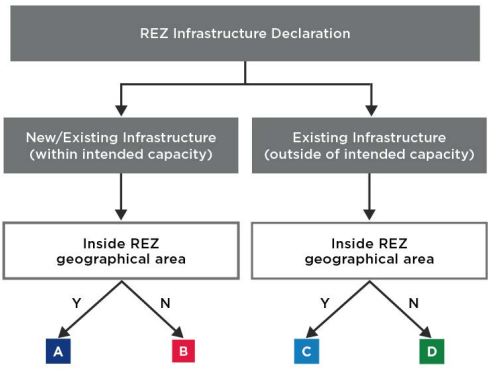
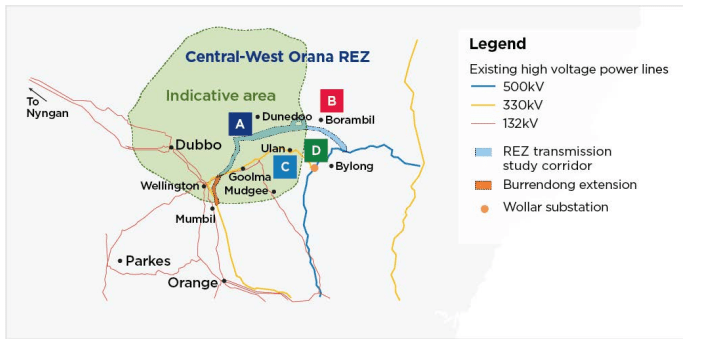
The two proposed access control mechanism options include:
It is proposed that certain projects will be grandfathered as part of the scheme, such that they can avoid being subject to the access scheme control mechanism. Namely, the access scheme control mechanism will not apply to projects that have either of the following within 6 months of the date of publication of the access scheme declaration:
Subject to formal adoption by the Energy National Cabinet Reform Committee, the CMM proposed by the ESB is targeted for implementation in 2025. Within the ESB's proposed model, it has outlined that where a bespoke REZ-specific access scheme is implemented prior to 2025, it may be integrated into, or applied in conjunction with, the CMM.
Under the CMM, generators will receive a congestion rebate for locating themselves within the REZ or less congested parts of the network. This is intended to provide generators with greater revenue and certainty regarding congestion risks.
The ESB has indicated it will release a detailed consultation paper in March 2022 on the proposed rule changes to incorporate the CMM. We will provide updates on any developments as they arise.
If the CMM is implemented, the Department has indicated that it will evaluate impacts on access right holders and determine whether it is appropriate to derogate in any aspect to the CMM to protect and maintain the substance of the REZ access scheme.
The access scheme will be delivered through a combination of an access scheme declaration, regulation and contract (i.e. the Project Delivery Agreement, Connection Agreement, Project Deed and Transmission Lease).
The access scheme declaration (to be made by the Minister) will be the primary statutory instrument that implements the access scheme and will (among other things):
The access scheme is anticipated to be declared in the fourth quarter of 2022. A draft access scheme declaration for the CWO REZ will be published by the Department as part of its consultation soon. A schedule of other draft access scheme declarations is due to be published in mid-2022.
The information provided is not intended to be a comprehensive review of all developments in the law and practice, or to cover all aspects of those referred to.
Readers should take legal advice before applying it to specific issues or transactions.



